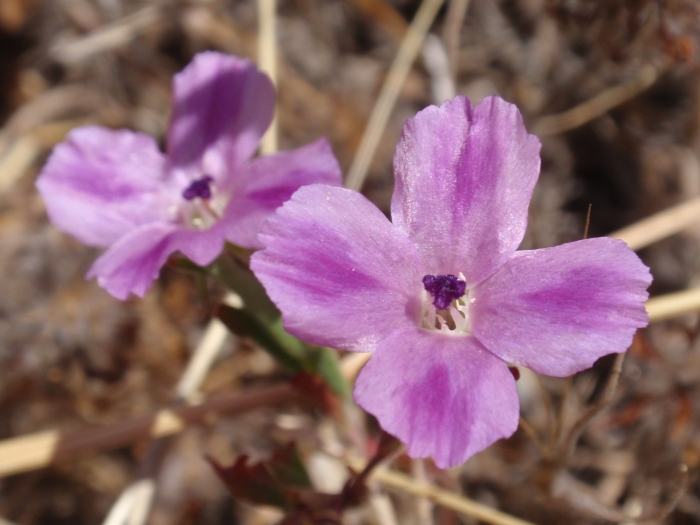Winecup Clarkia
(Clarkia purpurea)
Winecup Clarkia (Clarkia purpurea)
/
/

Tom Hilton
CC BY 2.0
Image By:
Tom Hilton
Recorded By:
Copyright:
CC BY 2.0
Copyright Notice:
Photo by: Tom Hilton | License Type: CC BY 2.0 | License URL: https://creativecommons.org/licenses/by/2.0 | Uploader: File Upload Bot (Magnus Manske) | Publisher: Wikimedia Commons | Title: Clarkia_purpurea_subsp._quadrivulnera.jpg | Notes: {{Information |Description={{it|1=Clematis_alpina (Clematide alpina) "Giardino Botanico delle Alpi Orientali" (loc. Monte Faverghera) Belluno, quota 1500 m s.l.m. [[Category:Clematis alpina]]}} |Source=Own work |Author=[[User:Enrico Bl

























































Estimated Native Range
Summary
Clarkia purpurea, commonly known as Winecup Clarkia, is an annual herb native to California, particularly found in chaparral, coastal sage scrub, and oak woodlands, as well as in open grasslands. It typically grows to about 60 centimeters tall, but may approach 1 meter (3 ft.) in height in ideal conditions. The plant has a slender, reddish stem and lance-shaped leaves. Its bowl-shaped flowers, which bloom from late spring to early summer, have four petals and come in shades of pink, purple, or deep wine red, often with a streak or spot of contrasting color in the center. The flowers are quite showy and attract native bees, making it a beneficial "honey plant" for pollinator gardens.
Winecup Clarkia is valued for its vibrant flowers and ability to attract pollinators. It is often used in wildflower gardens, native plant landscapes, and as a filler in annual borders due to its upright form and colorful blooms. This plant is relatively easy to grow, requiring full sun and well-drained soils. It is drought-tolerant once established, making it suitable for xeriscaping. While it can adapt to various soil types, it prefers those that are not too rich, as overly fertile soils can lead to leggy growth. Winecup Clarkia can self-seed under the right conditions, providing a recurring display year after year. However, it is not typically aggressive or invasive. Gardeners should be aware that it can be susceptible to powdery mildew in humid conditions.CC BY-SA 4.0
Winecup Clarkia is valued for its vibrant flowers and ability to attract pollinators. It is often used in wildflower gardens, native plant landscapes, and as a filler in annual borders due to its upright form and colorful blooms. This plant is relatively easy to grow, requiring full sun and well-drained soils. It is drought-tolerant once established, making it suitable for xeriscaping. While it can adapt to various soil types, it prefers those that are not too rich, as overly fertile soils can lead to leggy growth. Winecup Clarkia can self-seed under the right conditions, providing a recurring display year after year. However, it is not typically aggressive or invasive. Gardeners should be aware that it can be susceptible to powdery mildew in humid conditions.CC BY-SA 4.0
Plant Description
- Plant Type: Herb
- Height: 2-3 feet
- Width: 1-2 feet
- Growth Rate: Moderate
- Flower Color: Purple, Pink, Red
- Flowering Season: Fall, Spring, Summer
- Leaf Retention:
Growth Requirements
- Sun: Full Sun
- Water: Medium
- Drainage: Slow, Medium, Fast
Common Uses
Bee Garden, Bird Garden, Butterfly Garden, Deer Resistant, Drought Tolerant, Hummingbird Garden, Low Maintenance, Rock Garden, Showy Flowers
Natural Habitat
Native to chaparral, coastal sage scrub, oak woodlands, and open grasslands in California
Other Names
Common Names: Winecup Fairyfan, Purple Clarkia, Purpurclarkia
Scientific Names: , Clarkia purpurea, Clarkia purpurea var. hirsuta, Godetia purpurea var. lacunora, Clarkia romanzowii, Godetia purpurea var. elmeri, Godetia romanzowii, Godetia willdenowia, Oenothera humilis, Godetia decumbens
GBIF Accepted Name: Clarkia purpurea (Curtis) A.Nelson & J.F.Macbr.